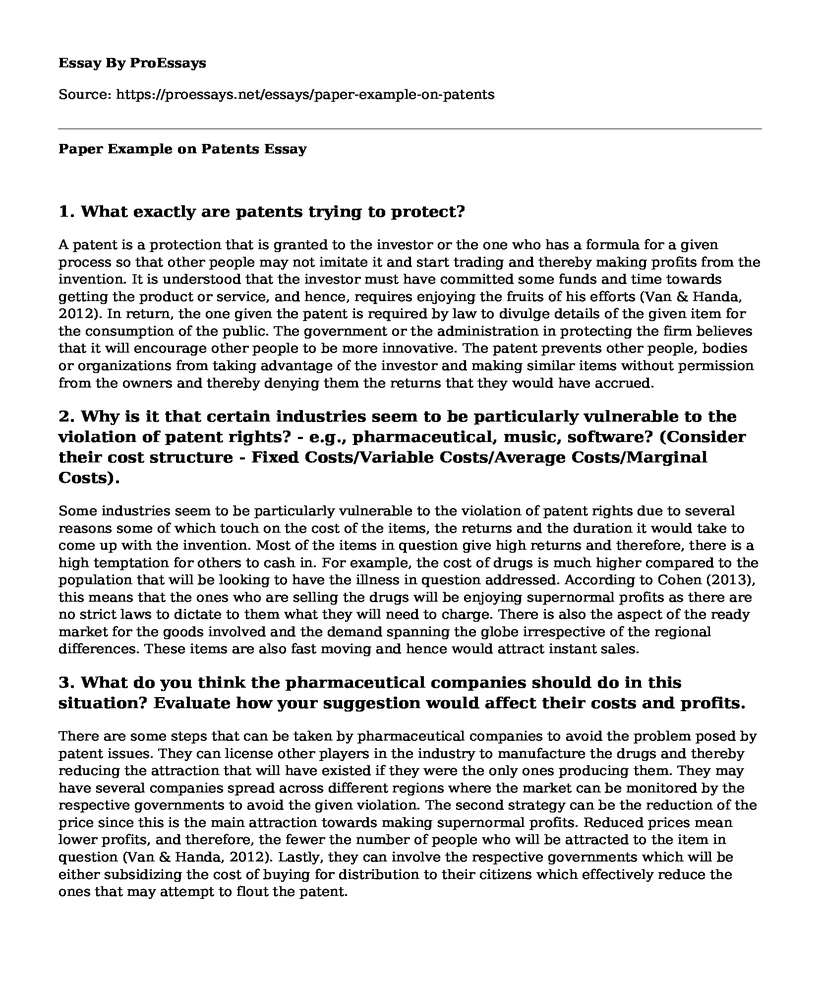1. What exactly are patents trying to protect?
A patent is a protection that is granted to the investor or the one who has a formula for a given process so that other people may not imitate it and start trading and thereby making profits from the invention. It is understood that the investor must have committed some funds and time towards getting the product or service, and hence, requires enjoying the fruits of his efforts (Van & Handa, 2012). In return, the one given the patent is required by law to divulge details of the given item for the consumption of the public. The government or the administration in protecting the firm believes that it will encourage other people to be more innovative. The patent prevents other people, bodies or organizations from taking advantage of the investor and making similar items without permission from the owners and thereby denying them the returns that they would have accrued.
2. Why is it that certain industries seem to be particularly vulnerable to the violation of patent rights? - e.g., pharmaceutical, music, software? (Consider their cost structure - Fixed Costs/Variable Costs/Average Costs/Marginal Costs).
Some industries seem to be particularly vulnerable to the violation of patent rights due to several reasons some of which touch on the cost of the items, the returns and the duration it would take to come up with the invention. Most of the items in question give high returns and therefore, there is a high temptation for others to cash in. For example, the cost of drugs is much higher compared to the population that will be looking to have the illness in question addressed. According to Cohen (2013), this means that the ones who are selling the drugs will be enjoying supernormal profits as there are no strict laws to dictate to them what they will need to charge. There is also the aspect of the ready market for the goods involved and the demand spanning the globe irrespective of the regional differences. These items are also fast moving and hence would attract instant sales.
3. What do you think the pharmaceutical companies should do in this situation? Evaluate how your suggestion would affect their costs and profits.
There are some steps that can be taken by pharmaceutical companies to avoid the problem posed by patent issues. They can license other players in the industry to manufacture the drugs and thereby reducing the attraction that will have existed if they were the only ones producing them. They may have several companies spread across different regions where the market can be monitored by the respective governments to avoid the given violation. The second strategy can be the reduction of the price since this is the main attraction towards making supernormal profits. Reduced prices mean lower profits, and therefore, the fewer the number of people who will be attracted to the item in question (Van & Handa, 2012). Lastly, they can involve the respective governments which will be either subsidizing the cost of buying for distribution to their citizens which effectively reduce the ones that may attempt to flout the patent.
4. In this case, the market system doesn't seem to get the goods to the people that need them. Do you think the government has already intervened too much (through the patent system) or needs to intervene further (to make sure the people that need the medicines get them)? Explain
The governments have the authorities and law enforcers on the ground to deal with any people who are attempting to go round the patent issue. The other way that the government is involved is by making the drugs more affordable to its citizens. They do this by procuring the cheaper generic forms from the firms licensed by the patent owners and in return awarding the patent owners with royalties (Cohen, 2013). They are paid a sum that is commensurate with the number of drugs purchased. This is one of the ways that the government works towards making critical drugs available to them. This also reduces the possibility of the company exploiting citizens by charging exorbitantly for essential drugs. Through this, they also deal with restrictive terms placed by insurance companies on the drugs to be prescribed.
References
Cohen, I. G. (2013). The globalization of health care: Legal and ethical issues. Oxford [UK: Oxford University Press.
Van, B. C. C., & Handa, S. (2012). Legal protection of software: Patents and trade-marks. Markham, Ont: LexisNexis.
Cite this page
Paper Example on Patents. (2022, Jun 19). Retrieved from https://proessays.net/essays/paper-example-on-patents
If you are the original author of this essay and no longer wish to have it published on the ProEssays website, please click below to request its removal:
- Traditional Healthcare Insurance
- Essay Sample on Computer Business Ethics
- Senegal Market Research: International Business
- Courageous Steps Needed: Moving Forward as a Whistleblower
- Essay on Evaluating Health Insurance Program: Taqueria Tsunami's Contribution Strategy
- Paper Example on High-Income Consumers and Low-Paid: Economic Demand & Supply
- Online Food Delivery Service - Free Paper Sample







